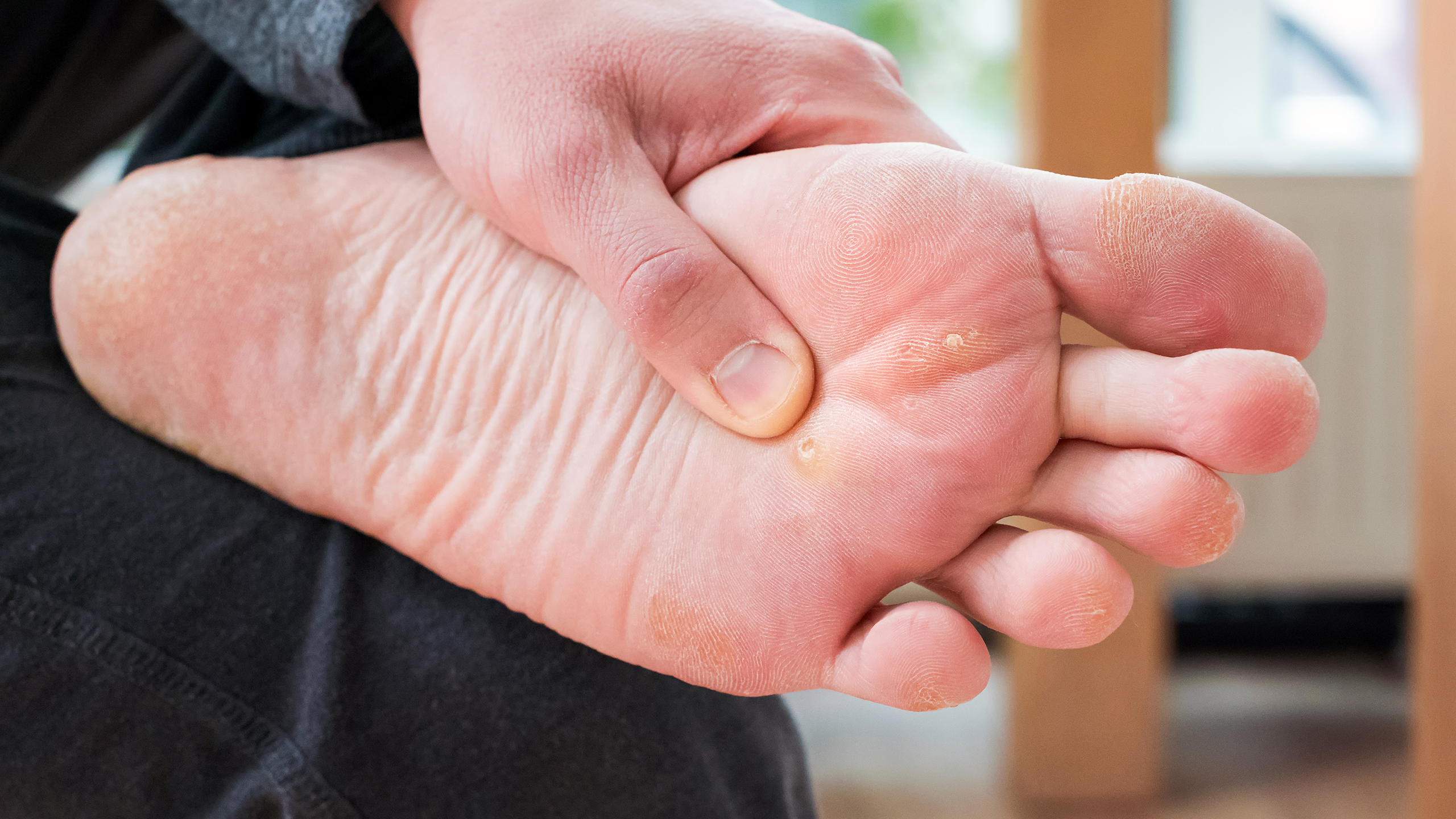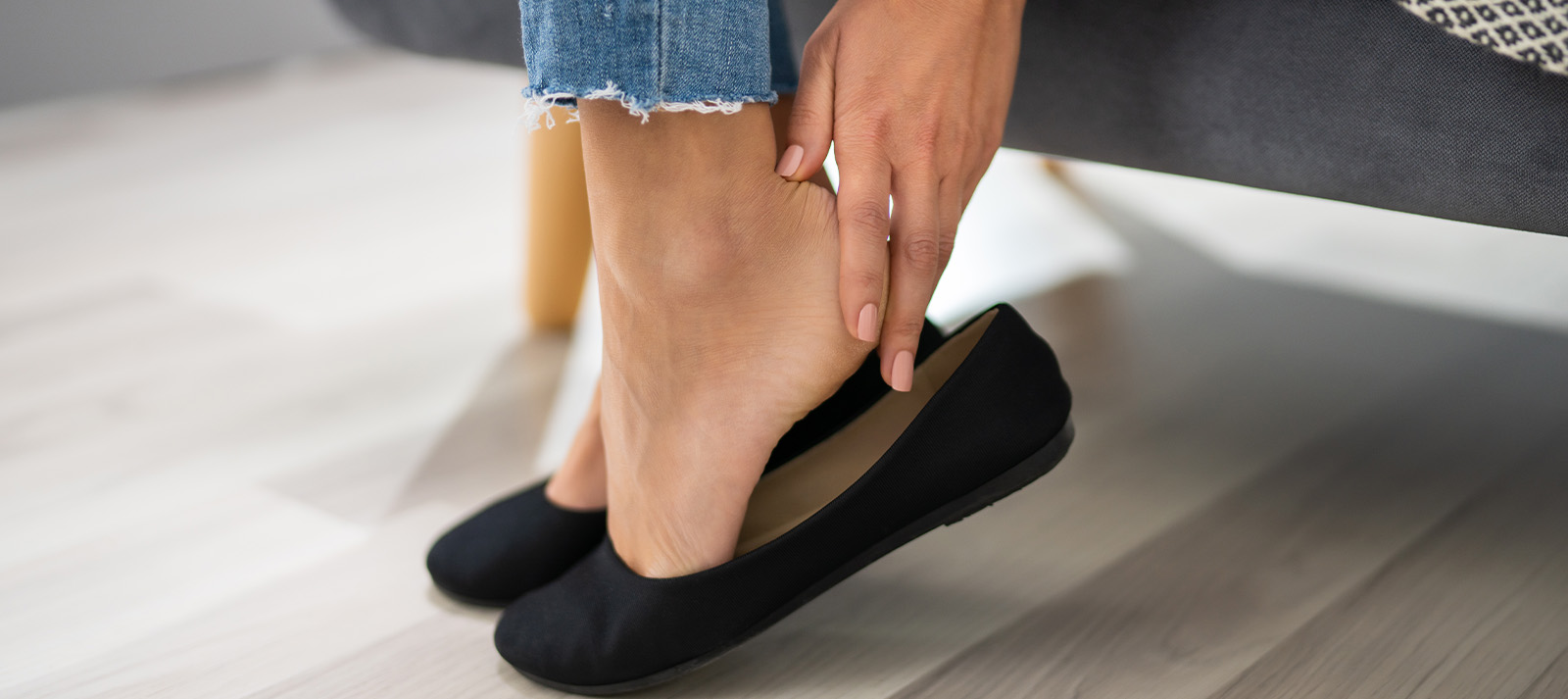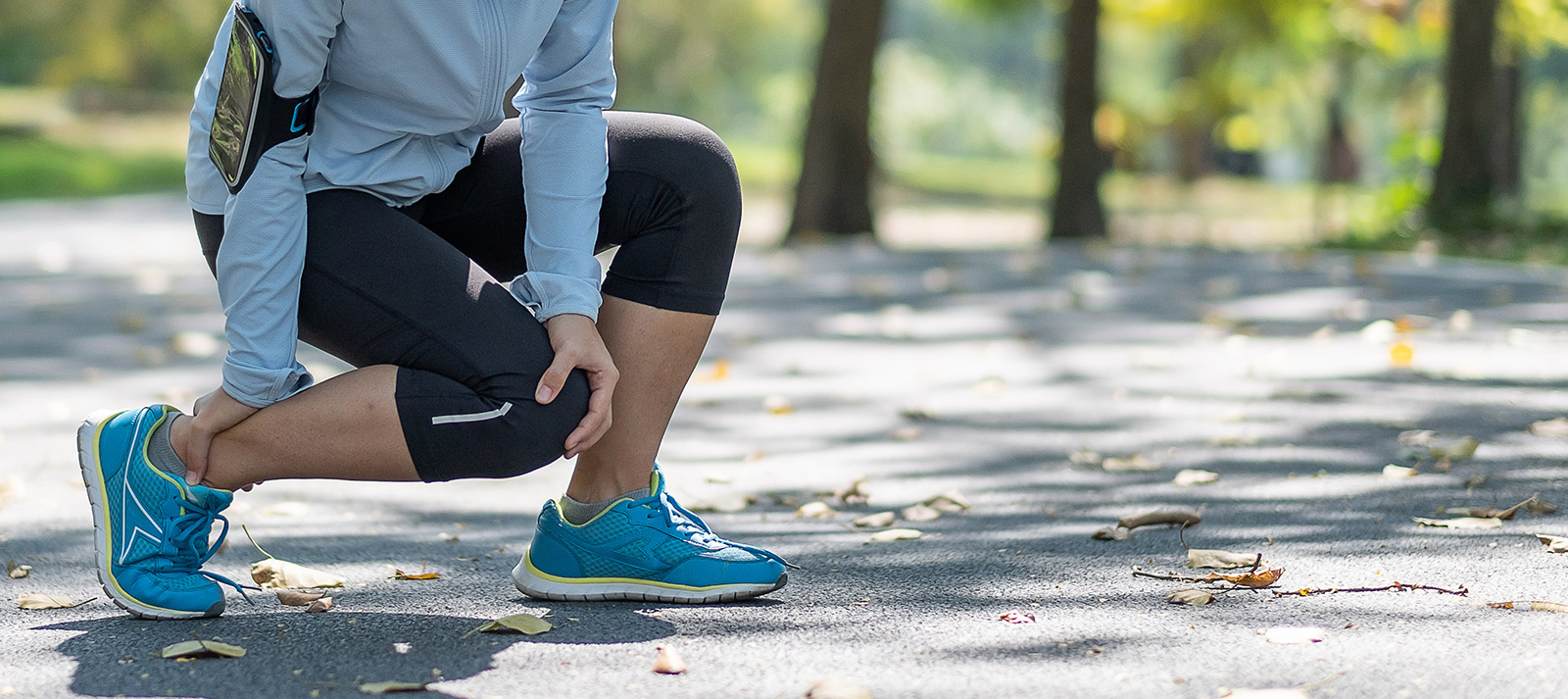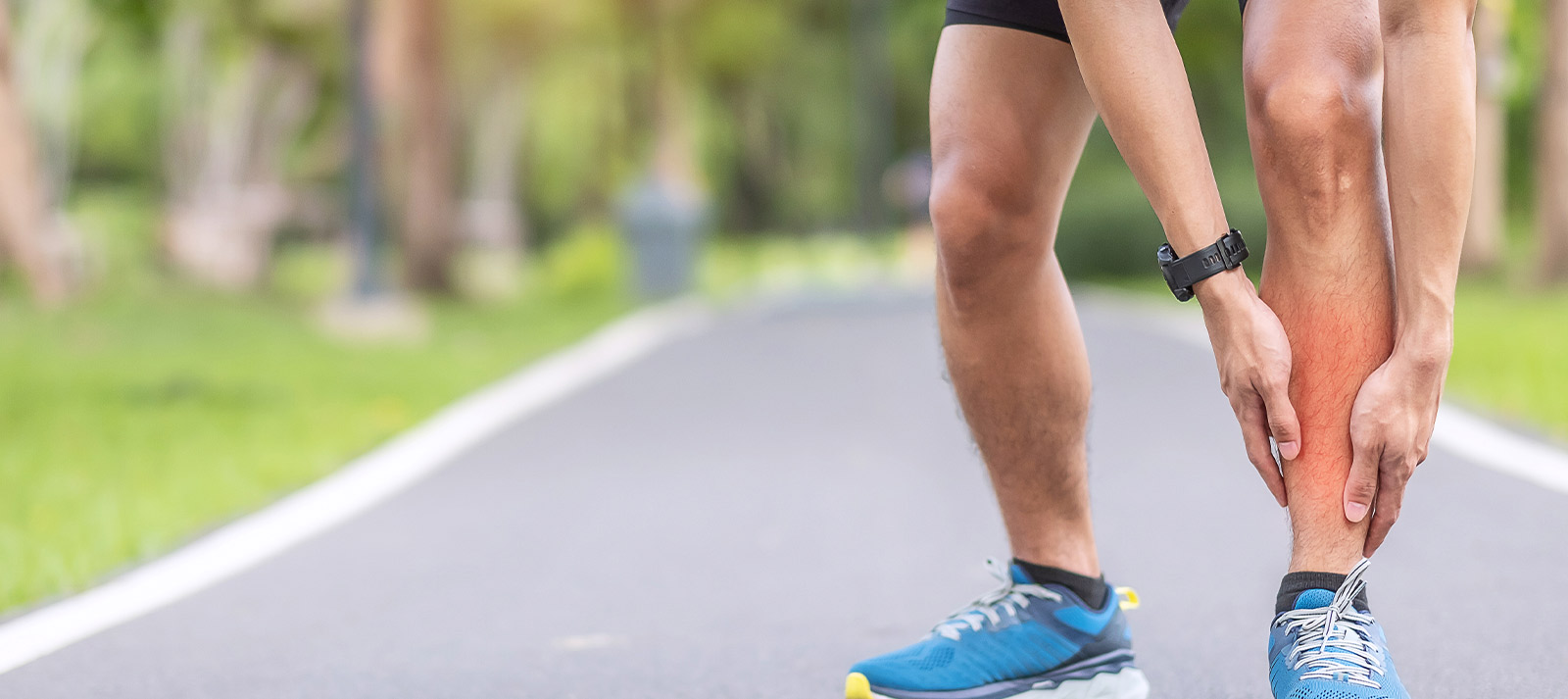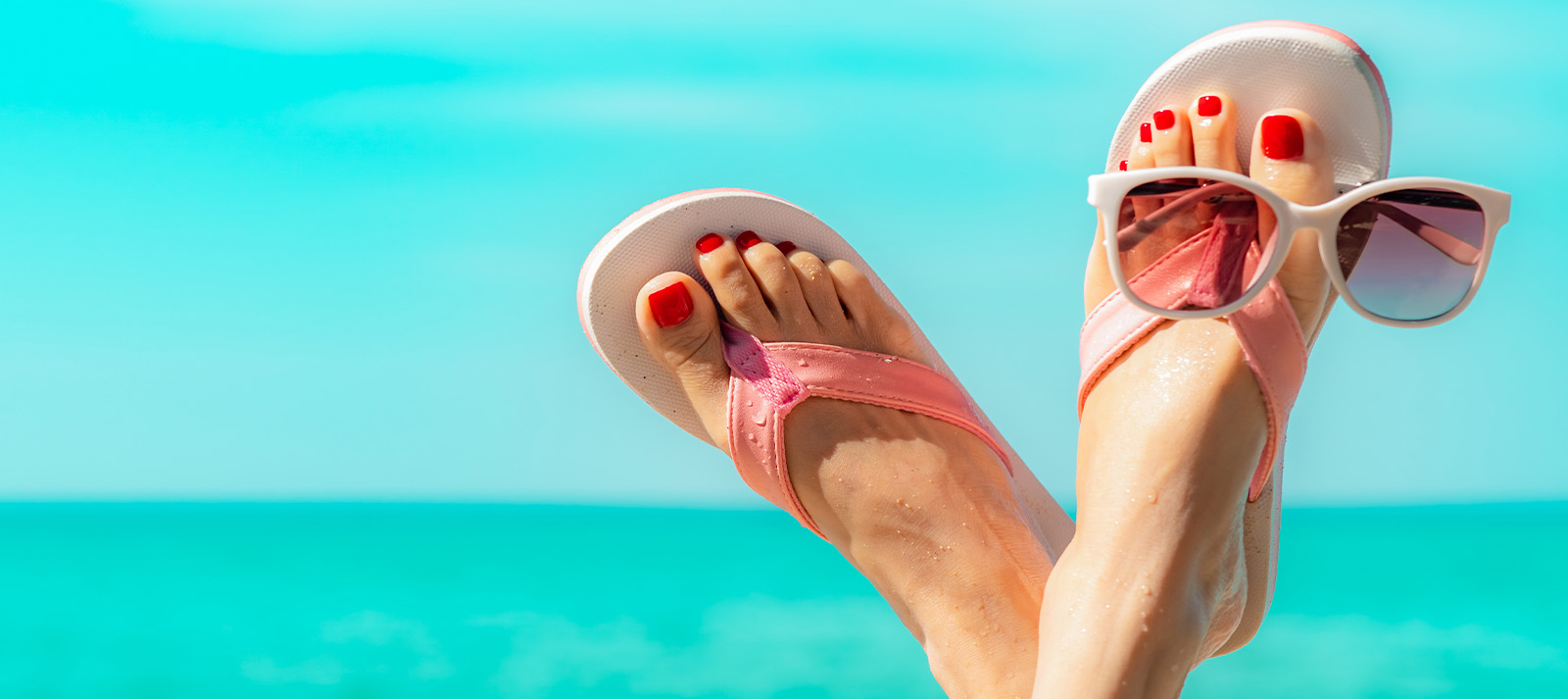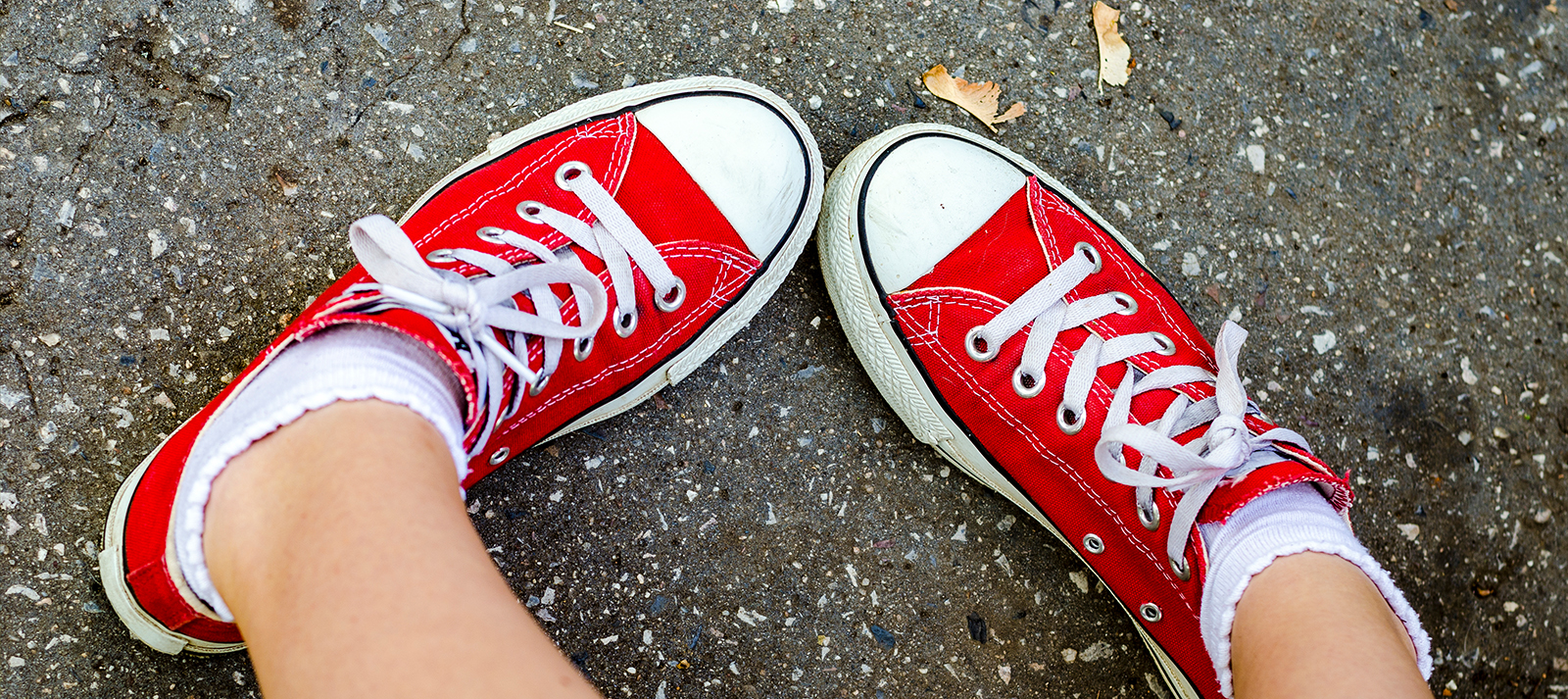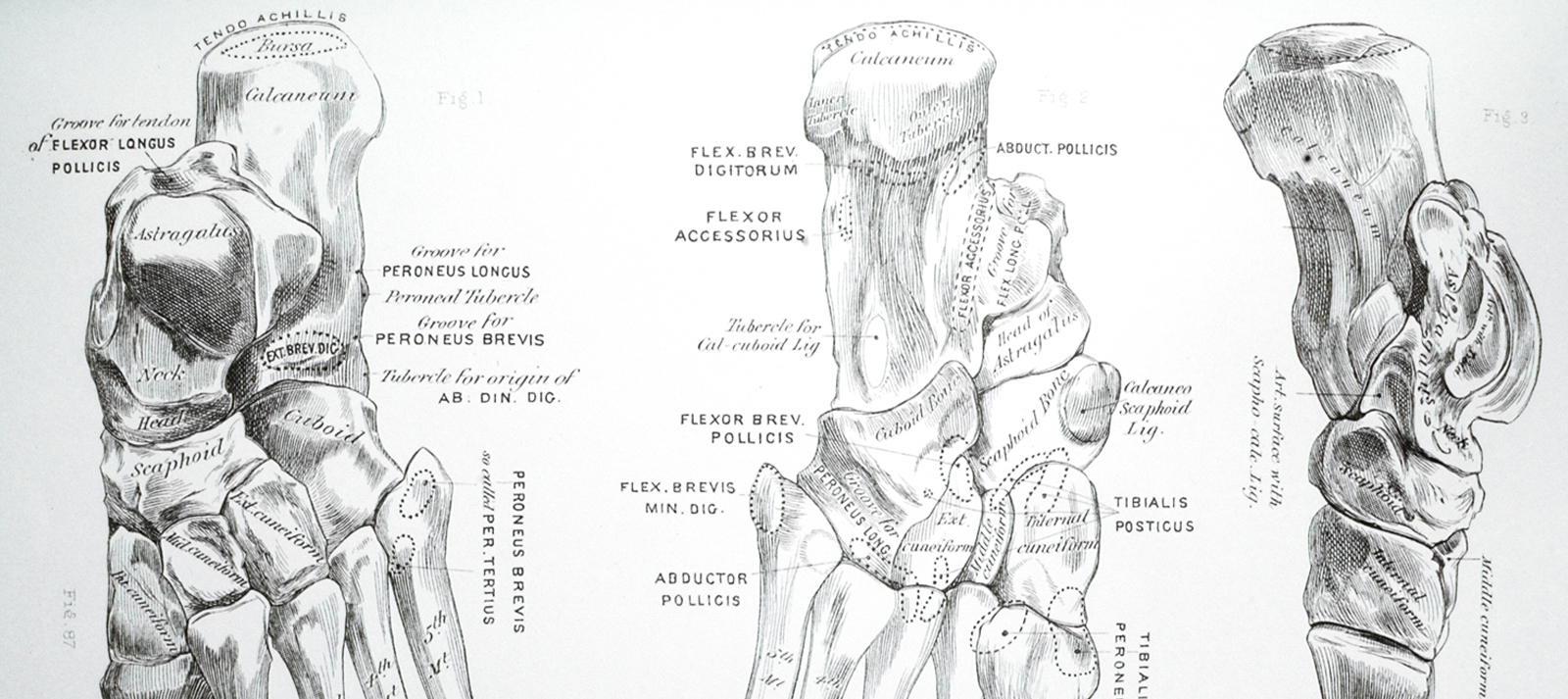Callus 101: Causes, Prevention and Treatment
Callus 101: Causes, Prevention and Treatment
Foot calluses, or rough patches of skin found on the ball, heels or small toes, is a normal occurrence for most people. Caused by compression and friction, foot calluses are your body’s way of protecting the skin underneath from irritation and pressure.
Though calluses are a normal occurrence for most people, some patients are more likely to develop calluses than others. If you walk without socks, wear shoes that are too narrow for your feet or you already have a medical condition that changes the normal alignment of the bones in your feet, you’re more likely to develop calluses on your feet.
How do I prevent calluses?
Foot calluses can be prevented by wearing proper socks and shoes, including proper fitting footwear both width and lengthwise. Ensuring that worn shoes are repaired and replaced regularly can give your skin some protection from the shock of walking on hard surfaces.
How do I treat calluses?
There are numerous home remedies to reduce the appearance of calluses, though the majority of calluses can be resolved with time off of your feet. You should refrain from using sharp objects to remove or reduce calluses, as this could lead to infection.
If you’re looking to reduce the calluses on your feet, try these home remedies:
- Epsom Salts: Soaking your feet in a handful of Epsom salts in a bath or basin of warm water for ten minutes can greatly soften calluses, especially before manual exfoliation
- Padding: Adding moleskin patches or soft pads can help to protect the skin from rubbing against shoes or socks.
- Shoe inserts: Cushioned insole, arch support and heal counters can help to reduce friction on the skin, especially by moving pressure away from any problem areas.
If you are still experiencing pain from your calluses, be sure to schedule an appointment with one of our board-certified foot and ankle specialists. At Balance Foot & Ankle, we’re here to restore your balance and get you back on your feet.
This Common Sneaker Mistake Could Be Upping Your Risk for Foot Fungus
This Common Sneaker Mistake Could Be Upping Your Risk for Foot Fungus
Source: Well+Good
Once you get a foot fungus, it can be really hard to get rid of—especially if it spreads to your toenails. And while there are a handful of reasons why the condition can come about in the first place—from walking barefoot in public areas to sharing a yoga mat without sanitizing it first—there’s one common mistake podiatrists see all the time: Not letting your damp sneakers fully air-dry before wearing them again. Do this, and you’re essentially sticking your foot into a breeding ground for infection.
“Fungi and bacteria thrive in moist, dark environments like shoes,” says Jacqueline Sutera, DPM, a New York City-based podiatrist and Vionic Innovation Lab member. “This can cause stinky feet and athlete’s foot infection, or fungus of the skin and nails.”
Your sneakers can get extra sweaty in hot summer temps, making a foot fungus more likely. To prevent the issue, Dr. Sutera recommends alternating between a few pairs of shoes. “Wearing the same shoes all day, everyday, will encourage stinky feet and infections,” she says. By rotating your sneakers, you’re able to give them a chance to dry out between uses.
If you’re especially prone to foot fungus, she says you can even switch your sneakers out during the day to prevent moisture from building up. The best pairs to reach for on extra-sultry days include those with breathable mesh or canvas uppers—bonus points if you pair them with moisture-wicking Merino wool socks.
Aside from having extra pairs of shoes on hand, you can also stock up on some of Dr. Sutera’s favorite foot fungus-fighting products. “Some great options are anti-fungal shoe deodorants, foot sprays, powders, tea tree oil foot soaks, and antiperspirants to help keep your feet and shoes fresh,” she says. “There’s even a very effective UV light machine that kills the fungus growing in shoes that can be used in between uses.” So there you have it—who knew that our kicks need rest days, too?
Please read the full article here
Top Home Remedies To Relieve Ankle Pain
Top Home Remedies To Relieve Ankle Pain
Your ankles are the key to running, jumping and just about any physical activity that involves movement. They support your body in unimaginable ways. In fact, your ankles have the ability to carry forces equivalent to several times your body weight.
However, that’s not all your ankles can do. Your ankles bring virtue to movement — empowering vertical and horizontal motion. Simply put, ankles are the reason we can jump up and down and turn left and right.
On average Americans walk 4,000 steps a day. Over time, this may significantly utilize your ankles and cause pain. Ankle pain can certainly slow down or change your lifestyle temporarily, but, in many cases, it isn’t a permanent injury. It may simply require some special at-home attention.
Why am I experiencing ankle pain?
Often a result of an accidental fall or injury during physical activity, anyone can experience ankle pain — regardless of age. The symptoms are typically quite clear — difficulty putting weight on your ankle, swelling, redness or simply general pain originating from your ankle.
Ankle pain can come in a wide variety of imbalances, such as sprains, fractures, arthritis, tendinitis, and more. Most commonly, ankle pain is caused by a sprain, which is an injury to the ligaments connecting to your ankle bones. This is often the result of a twist or movement that overstretches or extends your ligament.
What can I do at home as a remedy for ankle pain?
As soon as you notice ankle pain, or have an injury that strains your ankle, take preventative measures to help alleviate any lasting pain or swelling. That way you can get back on your feet as soon as possible.
To bring balance and remedy your ankle, just remember RICE — Rest, Ice, Compress and Elevate — a simple and established at-home method for ankle pain relief and recovery.
- Rest to protect your ankles and be sure to stop any activity that causes further agitation.
- Ice to reduce pain and swelling, using a cold pack at 10 to 20-minute intervals.
- Compress to decrease swelling, wrapping a bandage around your ankle.
- Elevate to alleviate pain and swelling, lifting your foot and applying an ice pack.
As soon as your ankle’s soreness and pain subside, make sure to stretch daily before attempting to return to normal activities and exercises.
We’re here to help you find your balance
So, when should you visit a podiatrist for your ankle pain?
If the RICE method and over-the-counter pain relievers do not seem to be helping, there may be other solutions that can only be provided by a podiatrist that understands your unique biomechanics. In some cases, custom orthotics can put you on the right path to recovery. However, everyone’s unique feet and ankles require innovative solutions that fit their lifestyle and body. So, it’s best to schedule an appointment directly with a podiatrist for foot and ankle pain relief.
From medical and surgical appointments to aesthetics and wellness, Balance Foot & Ankle’s well-rounded and comprehensive approach to foot and ankle treatment fosters an environment of excellence, hospitality and compassion within a contemporary yet warm setting.
Experience a balanced approach to total wellbeing at a location convenient for you.
Keys To Achieving Better Outcomes With Shin Splints
Keys To Achieving Better Outcomes With Shin Splints
Source: PodiatryToday
“I love the academic challenge that shin splints pose to figure out what is wrong and what muscle or tendon is contributing to the issue at hand. I break down shin splints into medial, lateral, anterior and posterior shin splints.” – Richard Blake DPM
Medial shin splints involve the posterior tibial tendon, flexor hallucis longus tendon or the flexor digitorum longus tendon.
Lateral shin splints involve the peroneus longus tendon or the peroneus brevis tendon.
Anterior shin splints involve the anterior tibial muscle, extensor hallucis longus tendon, extensor digitorum longus tendon or the peroneus tertius tendon.
Posterior shin splints involve the gastrocnemius muscle or the soleus muscle.
The actual definition of shin splints is pain between the ankle and the knee. There are a lot of structures with potential involvement that are important to consider when treating these symptoms.
When we treat shin splints, we can simply emphasize activity modification, some ice, general leg strengthening, and cross training, and most patients will do fine. However, if we treat shin splints with a little more zest, we can prevent reoccurrence. This may mean a longer running career for an athlete. For the patient who does not respond to simple measures, he or she could have compartment syndrome or tibial/fibular stress fractures. Muscle testing sometimes helps but most cases of shin splints are associated with muscle fatiguing when athletes get tired. This is hard to test in the office when the patient is rested although I normally have patients intensely work out or work out to the threshold of pain before their appointment late in the day. One muscle testing principle is to test the muscle in two basic positions: one where the patient has the advantage and one where the examiner has the advantage. When you test a muscle with the tendon shortened, you give the patient the advantage. When you test a muscle with the tendon stretched out, you (the examiner) have the advantage. At times, it is testing with the tendon stretched out that you find the weakness. You can pick up subtle weaknesses this way.
A thorough understanding of shin splints starts with classification as one of these four types and then delving into the function of the muscles. It is important to identify how the patient may have overused that muscle or muscle group. For the purposes of this blog, I will focus on medial shin splints.
If the patient presents with medial shin splints, we need to look for overuse with the posterior tibial, flexor digitorum longus and flexor hallucis longus muscles. These muscles have many functions but let us look at what they do at the ankle.
Since they all arise from the deep compartment, these muscles are ankle plantarflexors and ankle invertors. What is the primary ankle plantarflexor? That is the Achilles tendon but anything that makes the Achilles tendon weak can cause a patient to overuse one of the three muscles causing medial shin splints as they try to help the Achilles tendon perform its job. Typical weakness in the Achilles may stem from simple fatigue in doing a new sport or from adding hills to a running program. However, force-length physics considers an over-stretched Achilles or excessively tight Achilles weak. With the recent craze of zero-drop shoes, I now see more Achilles strain problems, the resultant weakness and then development of anterior or medial shin splints.
The ankle inverter function is probably the more common cause of medial shin splints. What taxes the inversion strength of these muscles? Excessive pronation can cause these three muscles to fatigue and strain as they attempt to decelerate the pronation. As the arch collapses in pronation, all three of these tendons can strain, but this is especially the case with posterior tibial tendon as the primary decelerator of rearfoot pronation at heel contact.
What are some of the causes of excessive pronation? Running itself with landing on the lateral side of the heel will cause two to four times more pronation than walking in many runners.1 Another one of the common causes of severe foot pronation is equinus. This tightness can be the cause of posterior shin splints but also anterior and medial shin splints. This is why a complete understanding of Achilles strength and flexibility is crucial. If the Achilles is tight, it is harder for the anterior extensors to dorsiflex the foot (thus causing anterior shin splints). If the Achilles is tight, the foot can pronate and the arch collapses (medial shin splints), both putting strain on the functions of the deep posterior compartment. If the Achilles is tight, the forefoot is forcibly loaded by ground reactive force, making it difficult to bend the toes in propulsion. Stress influences the long flexors (medial shin splints) and long extensors (anterior shin splints).
In Conclusion
So when a patient comes into my office with shin splints, I need to see what type he or she has (medial, lateral, anterior, or posterior) and determine what the patient did wrong other than add a new sport. I need to check for excessive pronation. I watch him or her run since running and walking for a patient can be totally the same or different. I need to measure for Achilles tightness or over-flexibility. I need the patient to wear his or her normal running shoes. If the patient is a pronator, I also want to categorize this as mild, moderate or severe so I can determine what level of support to offer in my treatment to lower the tissue stress threshold and allow healing.
This is where podiatry usually excels since proper shoes, custom or over-the-counter insoles, appropriate strengthening exercises and taping can speed up rehabilitation and prevent recurrence. In a future blog, I will discuss stress fractures, anterior and lateral shin splints, and other general rules.
Dr. Blake is in practice at the Center for Sports Medicine, which is affiliated with St. Francis Memorial Hospital in San Francisco. He is a past president of the American Academy of Podiatric Sports Medicine. Dr. Blake is the author of the recently published book, “The Inverted Orthotic Technique: A Process Of Foot Stabilization For Pronated Feet,” which is available at www.bookbaby.com.
Editor’s note: This blog originally appeared at www.drblakeshealingsole.com. It is adapted on PodiatryToday.com with permission from the author.
Reference
- Williams 3rd DS, McClay Davis I, Baitch SP. Effect of inverted orthoses on lower extremity mechanics for runners. Med Sci Sports Exerc. 2003;35(12):260-268.
Are Your Feet Beach Ready?
Are Your Feet Beach Ready?
Source: The Conversation
The summer sun sees us strip off. And from a podiatrist’s perspective, that’s means the arrival of new footwear, as people ditch boots and trainers for sandals and flip flops. For the past several months, our feet have been hidden away, and in some cases, neglected, but now, most of us want our feet looking and feeling good for summer.
So as an expert in feet, here are my top tips for things you can do to get your feet ready for the summer.
General foot care
When it comes to toe nails, cut straight across – avoid cutting down the sides of the nails as you run the risk of an ingrowing toe nail.
During the winter months our feet can become dry, cracked and form hard skin called callus. A useful approach to combat this is to soak your feet in warm water for about ten minutes and then use a pumice stone or foot file to lightly take the dry skin off. This should be followed by a moisturizer cream applied daily. For those who have particularly dry and callus feet, a cream with the ingredient urea (which can hydrate and regenerate the skin, soothe irritations and soften the top layer of the skin) can be very useful.
If your feet are very dry, you may wish to put on a pair of socks after the application of the cream to increase absorbency. And if you do suffer with callus that is not responding to self-care, or you have corns – concentrated hard areas of skin that occur on the joints of the toes or on the bottom of your forefoot – then you will need to see a registered podiatrist.
If your feet are dry, with a scaly-type of rash or the skin is itchy you may have Athlete’s foot which is a fungal infection. Likewise, if you have thickened and discolored nails that crumble on cutting, it may also be due to a fungal infection known as onychomycosis. While it is tempting to cover them up with nail varnish don’t – this will only make the problem worse. Again a registered podiatrist can help and there are a number of over-the-counter fungal topical products that a pharmacist can advise you about.
Summer footwear
The less-is-more approach to footwear in the summer has many of us donning sandals and flip flops, the latter of which in particular offers minimal protection and support to the foot and lower limb. Changes to footwear styles and an increase in activity – summer walks in parks and along the beach, for example – can increase the chance of injury to the foot. In the case of flip flops, the separator between the first and second toes can cause all of the toes to claw (curl) during “toe-off” as we walk to keep the flip flop on, since there is little support across the top of the foot. This can increase the stress and forces within the forefoot area and for some individuals, the separator between the first and second toes can cause irritation of the skin resulting in blistering during the early stages of wear.
We advise that individuals stage the use of less supportive footwear such as flip flops and sandals with more supportive footwear – trainers, lace ups.
In addition, where possible, for those who wear sandals, it is advised that a style which incorporates a strap mechanism across the top of the foot be worn. By adopting a staged approach to summer footwear, it can allow the feet to adapt and minimize the risk of problems that could occur within your foot, ankle and lower limb – this can include forefoot pain, heel pain (tendinitis), fractures, strains and sprains.
It is important to note that if you have poor circulation, diabetes and/or a loss of sensation of your feet (neuropathy) you will need to be extra cautious. Remember, everyone needs to protect and care for their feet – looks are important, but pain-free walking in the summer sun is even more essential.
Should I Worry If My Child Is Pigeon-Toed Or Duck-Footed?
Should I Worry If My Child Is Pigeon-Toed Or Duck-Footed?
Source: The Conversation
Babies regularly have their feet, legs and hips checked by their doctor in hospital, or at maternal and child-health nurse visits.
As children grow, parents are often concerned about their feet pointing inwards when they walk (also called in-toe or pigeon-toed walking) or outwards (also called out-toe walking or duck-footed).
These walking positions, commonly called “rotational deformities”, often cause parents to seek the opinion of an orthopaedic surgeon, physiotherapist or podiatrist for more specialized assessment.
Rotational deformities
When the leg or foot faces inwards or outwards during walking, it may be from a number of typical changes in the leg or foot.
When a baby is born they often have bowed or curved legs. This is thought to be because of the position of the baby in the womb.
This position can remain and seem more obvious when the child begins to walk. It may appear as if the feet face inwards. Sometimes children may appear to trip or fall over their own feet.
In-toe walking may come from a curved foot (metatarsus adductus) or an inwards twist in the leg bones (tibial or femoral torsion).
Similarly, out-toe walking may appear from the foot or leg. A foot that is very rolled in or “pronated” may appear as if it is pointing outwards. A leg may also turn outwards from the leg bones or the hip.
The flexibility of a child’s joints or the way they use their muscles could also cause in-toeing or out-toeing. A twist in their bones is one possible contributing factor to in-toe or out-toe walking.
Curved feet
Metatarsus adductus is the most common foot deformity in infants. In metatarsus adductus, the foot has a curved or banana-shaped appearance. In 95% of cases, the foot corrects itself with no treatment.
In the past, it was recommended to put shoes on the wrong feet. This is no longer recommended as it may cause further foot deformity.
Sometimes treatment is needed. Plaster casting or splinting may be required to help the foot straighten if it doesn’t on its own.
Parents should see a health professional if their child’s foot is curved, stiff and unable to be straightened, or isn’t straightening as their child gets older.
Twisted shin bones
Tibial torsion is where the lower leg or tibia turns in or outwards. An inward-turned tibia is common in children under the age of three. It usually straightens after this age and sometimes even slightly turns outward with no treatment. These changes occur in children up to the age of eight.
Health professionals will sometimes recommend children with in-toe walking wear a type of orthotic called gait plates. While gait plates may provide some cosmetic effect when worn, there is no evidence they will result in long-term change.
Parents should be cautious about claims these devices will fix in-toe walking. They need to consider if the expense is worth it for something that will naturally get better on its own. There is no good evidence stretches or footwear will change this type of walking.
Turning inwards or outwards at the hip
Femoral torsion is where the upper leg bone (femur) or hip is turned in or outwards. Children may appear to walk with their feet inwards or outward. It also looks like their knees point inwards or outwards.
The femur goes through many changes up to the age of 12 and an inward turn at the hip is more commonly seen in girls. Rotational changes at the top of the leg are also a very normal part of growth.
Walking changes from the top of the leg and hip sometimes appear more common in children who frequently W-sit. This sitting position is with their bottom on the ground and legs folded outwards.
There is no research proving sitting like this is harmful, but therapists often observe hip muscle tightness in children who sit this way and it may affect the child’s walking. As harm is unknown, it might be best to get children to sit or play in other positions.
There are no shoes, orthotics, garments, taping or stretches that have evidence supporting them being used to change walking associated with these rotational changes. Parents should seek medical attention quickly if there is pain at the hip or pain extends into the groin while walking at any age.
Children walk in-toe and out-toe for many reasons. Parents should see a health professional if their child is tripping from their leg position when their child is school-aged, if one leg turns substantially more inwards or outwards than the other, seems longer or looks very different compared to the other.
For the majority of children, in-toe or out-toe walking is just part of growth.
Should You Take 10,000 Steps a Day for a Balanced Life?
Should You Take 10,000 Steps a Day for a Balanced Life?
Is 10,000 the magic number? Well, it all depends on your current fitness level and your goals. The average American walks 3,000 to 4,000 steps a day, that’s about 1.5 to 2 miles. Understanding how many steps you walk now is a great way to establish your baseline to plan for the future. But before you do anything, it is important to first define your goals, such as to:
- Increase general health, wellness and fitness
- Decrease weight
- Maintain health
Increase general health, wellness & fitness
If you’re new to exercising or returning from an injury, you’ll want to start slowly to avoid burnout or further injury. After you have established your baseline, you can work up toward your goal by adding 1,000 extra steps a day each week. Meeting your goal could be as simple as an extra five-minute walk, or even parking further away in the parking lot at the grocery store.
Decrease weight
With a little math, you can determine how many steps you need to take each day to achieve your weight goal. The Academy of Nutrition and Dietetics recommends slow weight loss for lasting results. This translates to about 1/2 pound to one pound per week. Completing an extra 10,000 steps each day could burn about 2,000 to 3,500 extra calories each week. One pound of body fat equals 3,500 calories, so depending on your weight and workout intensity, you could lose about one pound per week simply by adding 10,000 steps each day.
Maintain health
Maintaining your desired goal could be just as challenging as achieving your goal if you don’t have the right plan in place. The 10,000-step goal could be right for you—and the benefits of a 30-minute daily walk are impressive, helping to reduce your risk of common health problems such as:
- Heart disease
- Obesity
- Diabetes
- High blood pressure
- Depression
Additionally, one study out of California State University showed that mood lifted in correlation with increased numbers of daily steps, and researchers at the Harvard School of Public Health found that 30 minutes of walking each day cut stroke risk by a minimum of 20%. It’s important to note ethat you will also burn calories and fat and enjoy vitamin D from the sun while you’re in the sun.
Simple Solutions
So, how can you include more steps in your day?
- Take the stairs
- Take the dog for a walk
- Walk while listening to music to make your walk more enjoyable and help motivate you to walk farther or faster
- Instead of sending a work email, walk to your colleague’s desk
- Have a walking meeting versus sitting in the office
- Walk while waiting: Take a walk instead of sitting while you’re waiting for an appointment
- Break up the day with workday walks by setting reminders on your calendar for short walking breaks to increase energy throughout the day
- Choose parking spots farther away from the entrance. If you take the bus, get off a stop early and walk the rest of the way.
Your goal will depend on your starting point. However, everyone can gain the benefits of walking more, step by step. We hope you find a balanced approach to improve your wellbeing from head to sole.
If you find that you need help along the way to care for any foot or ankle pain, or even injury, let us know. Together, we can find foot and ankle health and wellness solutions to help you move beyond the issues preventing you from achieving your wellness or exercise goals.
A Note of Reassurance
A Note of Reassurance
The health, safety and well-being of our patients, visitors, employees, and our community is top priority.
As a medical facility, we already adhere to strict practices and policies of cleaning and sanitation daily. Given the current situation, we are taking additional steps to be extra vigilant and keep our office safe for our patients. These additional measures include increasing the frequency of cleaning all surfaces and areas with antibacterial and antimicrobial cleaning products recommended by the CDC. We have added a medical grade HEPA/HEGA air filter purification unit in our office which filters greater than 95% of all dust, spores, mold, bacteria, viruses, chemicals, and gases larger than 0.100 microns. Scientists say that the size of the Coronavirus is 0.125 microns. Therefore, the air filter purification unit is designed to capture airborne particles of this size. Additionally, masks and alcohol-based hand sanitizer is readily available. Thank you for your understanding and cooperation.
Stay Safe & Healthy –
Dr. Jennifer L. Prezioso, DPM, FACFAS
BarkingDogShoes.com Guest Column: The Podiatrist is in! Meet Dr. Jennifer Prezioso
BarkingDogShoes.com Guest Column: The Podiatrist is in! Meet Dr. Jennifer Prezioso
Have you ever found yourself, at the end of an evening, thinking of nothing other than getting home and switching out your gorgeous-but-painful pair of shoes in exchange for an old pair of slippers that has seen better days but never lets you down? If yes, then pull up a chair, have a seat, and welcome home. My name is Dr. Jennifer Prezioso, and I am a shoe lover (and hater) just like you. But, as a Podiatric Surgeon, board certified by the American Board of Foot and Ankle Surgery, I am also a dedicated member of the world of Foot and Ankle specialists striving to help people understand their individual foot type and how to make sure they are making healthy shoe choices. So I not only empathize with those who adore shoes but face footwear challenges, I also advocate for them every day. I recently had the opportunity to write a guest column for BarkingDogShows.com on this very topic. If you would like to learn more, read the full article here.
Source: BarkingDogShoes.com

